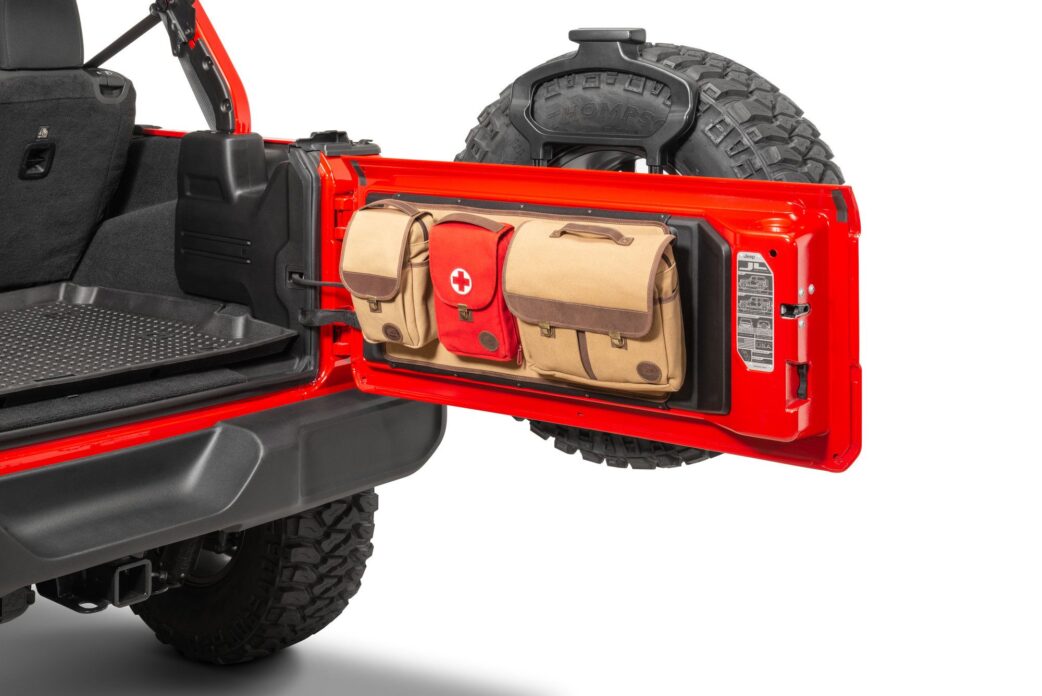Removing the interior panel of a tailgate is a relatively simple process that can be done by anyone with basic mechanical skills. Whether you need to replace a broken component, access the inner workings of your tailgate, or simply want to upgrade the panel, follow these steps to safely remove the interior panel of your tailgate.
How to remove tailgate interior panel
In order to remove tailgate interior panel you have to:
- Gather the necessary tools and materials: Before starting the removal process, make sure you have all the tools and materials you will need. These may include a screwdriver (Phillips or flathead), a trim panel removal tool, a socket wrench set, and a clean cloth or carpet protector for storing the removed panel. It’s also a good idea to have a container or bag to store any small screws or clips you may remove.
- Prepare the workspace: Find a well-lit area with enough space to move around comfortably. If you are working outside, make sure the ground is level and clear of any debris that could hinder your work. Lay down a clean cloth or carpet protector to prevent damage to the interior components you remove.
- Open the tailgate: Lift the tailgate and make sure it is securely propped open to prevent any accidental closures while you are working on the panel. Use a tailgate prop or a sturdy object like a wooden block to hold it in place. This step is crucial for your safety and allows easy access to the panel.
- Locate the mounting points: Inspect the tailgate interior to identify the mounting points of the panel. These are usually located along the edges and sometimes in the center of the panel. Look for visible screws, clips, or plastic push pins that secure the panel in place.
- Remove the screws and clips: Carefully remove any visible screws or clips holding the panel to the tailgate frame. Use a screwdriver or a trim panel removal tool to release the clips or pry off the plastic push pins. Take your time and be gentle to avoid damaging the clips or scratching the panel.
- Test for additional mounting points: Even after removing the visible screws and clips, some interior panels may have hidden or additional mounting points to secure them in place. Gently pull on the panel to check for any resistance or give. If you encounter resistance, carefully inspect the area to identify any hidden mounting points and remove them accordingly.
- Disconnect electrical connections: If your tailgate has electrical components such as power windows, locks, or speakers, you may need to disconnect some electrical connections before fully removing the panel. Look for any wire harnesses or connectors attached to the panel and carefully disconnect them by gently pulling them apart. Be mindful of any locking tabs or mechanisms that may need to be released first.
- Remove the panel: Once all the mounting points and electrical connections have been disconnected, gently lift the panel upwards, starting from the bottom. Take care to support the panel’s weight and ensure it does not snag on any remaining components. If the panel feels stuck or does not come off easily, double-check for any missed mounting points or clips.
- Store the removed panel safely: Once the panel has been successfully removed, set it aside on the clean cloth or carpet protector you prepared earlier. This will protect it from scratches or damage while you work on other components. If you plan to reinstall the same panel later, take extra care not to drop or mishandle it.
How to remove tailgate trim?
Whether you’re looking to replace a damaged tailgate trim or simply want to upgrade to a different style, removing the existing trim on your vehicle is typically a straightforward process. With a few basic tools and some patience, you can successfully remove the tailgate trim without causing any damage to your vehicle. In this guide, we’ll walk you through the step-by-step process of removing the tailgate trim.
Before you begin the removal process, it’s important to gather all the necessary tools and equipment. You will need a flathead screwdriver, a trim removal tool, a plastic pry tool, and a clean cloth or towel to protect your vehicle’s paint from any scratches. It’s also important to work in a well-lit area to avoid any mistakes.
Here is a step-by-step guide on how to remove the tailgate trim:
Step 1: Open the tailgate and locate the screws or clips holding the trim in place. These are usually located on the outer edge or bottom of the tailgate. Remove any screws with a screwdriver and set them aside in a secure place.
Step 2: Using a trim removal tool or a plastic pry tool, carefully pry the trim away from the tailgate. Start at one end and work your way to the other, gently applying pressure to release the clips holding it in place. Be cautious not to use excessive force to prevent any damage to the trim or the paintwork.
Step 3: If you encounter resistance while prying the trim, chances are there may be additional clips or screws that need to be removed. Inspect the trim thoroughly to ensure all fasteners have been removed or released.
Step 4: Once the trim has been fully detached from the tailgate, gently pull it away from the vehicle. However, be mindful of any electrical connections such as wiring harnesses for tailgate lights or cameras. Carefully disconnect these connections to fully remove the trim panel.
Step 5: If there is any adhesive holding the trim in place, use a clean cloth or towel to apply heat from a hairdryer or heat gun. This will soften the adhesive, making it easier to remove the trim. Take caution not to overheat the plastic trim, as it may warp or deform.
Step 6: Clean the surface of the tailgate to remove any adhesive residue or dirt. You can use a mild soap and water solution and a soft cloth. Make sure to dry the area thoroughly before proceeding.
Step 7: Before installing any new trim, inspect the tailgate for any damage or corrosion. If necessary, address any issues before proceeding with the installation.
Removing the tailgate trim is relatively simple; however, it requires patience and attention to detail to avoid causing any damage. Take your time, and if you encounter any difficulties along the way, refer to your vehicle’s manual or consult a professional for guidance.
In conclusion, removing the tailgate trim can be done by following these simple steps. It’s essential to approach the process with care and attention to prevent any damage to your vehicle. Remember to gather all the necessary tools, work in a well-lit area, and take your time. Once the trim has been successfully removed, you can proceed with replacing or upgrading it to achieve the desired look for your vehicle.
How do I remove a Freelander tailgate panel?
If you own a Land Rover Freelander and need to remove the tailgate panel for any reason, it’s a relatively straightforward process that can be completed with basic tools. Whether you want to fix a broken component, replace a damaged panel, or access the inner workings of the tailgate, this step-by-step guide will walk you through the process:
Step 1: Gather the necessary tools and equipment
Before you begin the removal process, gather the tools and equipment you’ll need. These typically include a socket set, a trim removal tool or a flathead screwdriver, and a Phillips head screwdriver. Additionally, it’s a good idea to have a container to store and organize the screws and small components you’ll be removing.
Step 2: Disconnect the negative battery terminal
To ensure safety during the removal process, it’s essential to disconnect the negative battery terminal. Locate the battery, which is usually located under the bonnet, and use a socket wrench to loosen the terminal nut. Once loosened, carefully remove the cable from the negative terminal and position it away from the battery to prevent accidental contact.
Step 3: Remove the tailgate handle trim
Using a trim removal tool or a flathead screwdriver, gently pry off the tailgate handle trim. Start by inserting the tool between the trim and the tailgate panel and gradually work your way around, releasing the clips securing the trim in place. Once all the clips have been released, remove the trim and set it aside.
Step 4: Remove the tailgate license plate trim
Next, you’ll need to remove the license plate trim, which is usually held in place by screws or plastic clips. Locate these fasteners and use the appropriate tool (e.g., Phillips head screwdriver) to remove them. Once the fasteners have been released, carefully remove the license plate trim and keep it in a safe location.
Step 5: Disconnect the wiring harnesses
Inside the tailgate, you’ll find various wiring harnesses connected to components such as the license plate lights, rear wipers, and central locking mechanism. Before proceeding further, disconnect these wiring harnesses by locating the connector plugs and carefully separating them. Take note of their positions and connections to ensure correct reassembly later.
Step 6: Remove the tailgate inner trim panel
Now it’s time to remove the inner trim panel of the tailgate. Starting from the bottom, locate and remove the screws or plastic clips securing the panel in place. Once all fasteners have been released, carefully lift and remove the trim panel from the tailgate. Take care not to damage the panel or any components attached to it during removal.
Step 7: Remove the tailgate exterior trim panels (optional)
If you need to access the outer components or fix a particular issue on the tailgate, you may need to remove the exterior trim panels. This step will vary depending on your specific Freelander model and the components you need to reach. Generally, this involves removing screws or clips securing the panels in place and carefully pulling them away from the tailgate.
Step 8: Remove the tailgate lock assembly (optional)
If you need to replace or repair the tailgate lock assembly, you’ll need to remove it from the tailgate. This typically involves locating and removing the screws or bolts securing the assembly. Once released, carefully disconnect any wiring harnesses attached to the lock assembly and set it aside for repair or replacement.
Step 9: Reassemble the tailgate (if applicable)
Once you’ve completed the necessary repairs or replacements, it’s time to reassemble the tailgate. Follow the steps in reverse order, ensuring you connect any wiring harnesses correctly and tighten all screws or fasteners securely. Carefully align the trim panels before applying pressure to snap them back into place. Double-check that all components are securely fastened and functional.
Step 10: Reconnect the negative battery terminal
Finally, after the tailgate panel is successfully reassembled, it’s important to reconnect the negative battery terminal. Position the cable back onto the negative terminal and tighten the terminal nut with a socket wrench. Ensure that the connection is secure and free of any looseness.
By following these steps, you can easily remove the tailgate panel of your Land Rover Freelander. Whether you’re addressing a specific issue or simply performing routine maintenance, this process will allow you to access the inner workings and components of the tailgate with ease.



